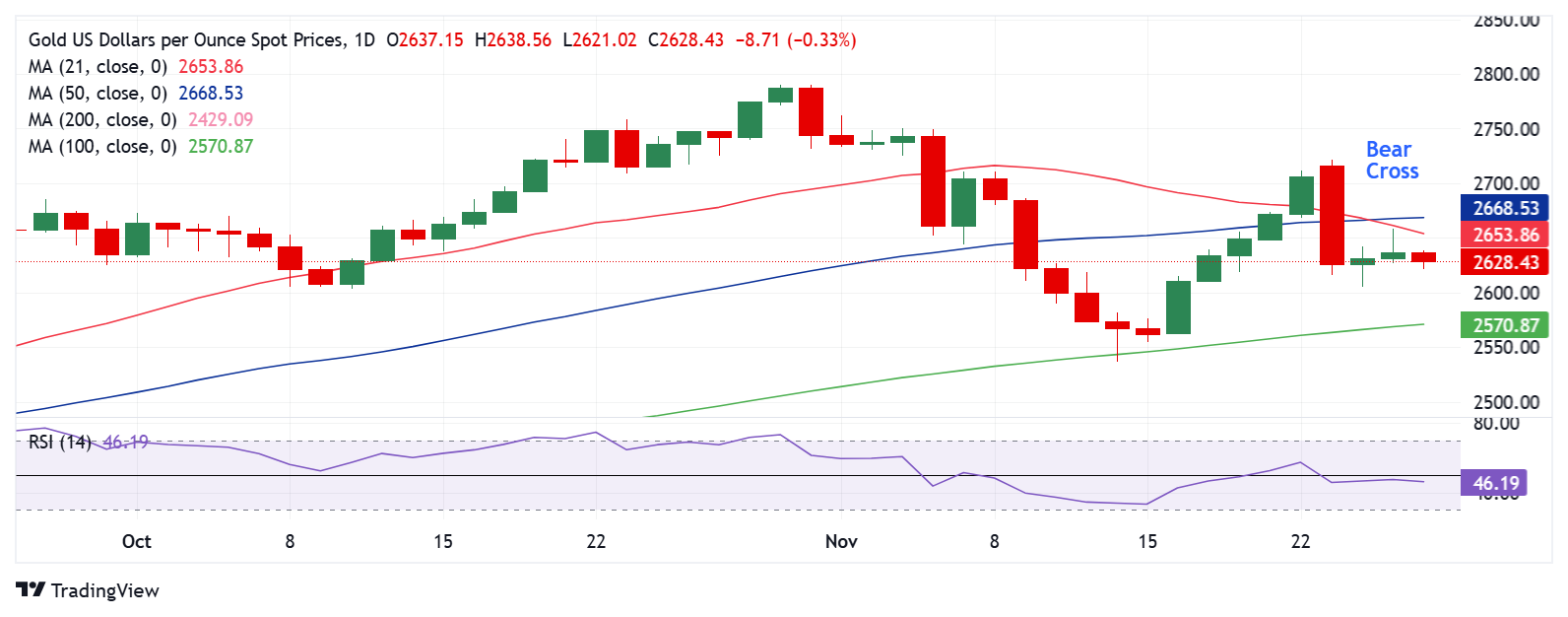- Gold price returns to the red early Thursday as US Dollar pauses decline alongside US Treasury bond yields.
- Bear Cross and bearish RSI on the daily chart continue to favor Gold sellers.
- Gold price remains subject to intense volatility due to Thanksgiving Day holiday-led thin liquidity.
Gold price reverts toward the weekly low of $2,605 in Asian trading on Thanksgiving Thursday, snapping a two-day recovery. The US Dollar (USD) and the US Treasury bond yields breathe a sigh of relief, exerting downward pressure on the Gold price amid holiday-thinned trading conditions.
Gold sellers fight back control
Following a profit-taking decline so far this week, the USD appears to have regained its footing, even though the uptick in US Treasury bond yields seems temporary amid uncertainty over the implications of US President-elect Donald Trump’s tariff plans on economic prospects and the Federal Reserve’s (Fed) interest rate outlook.
Markets witness renewed jitters amid a tech sell-off on Asian indices following fresh reports that the US is expected to announce another set of measures on Monday to restrain China's ability to develop advanced artificial intelligence (AI).
The fresh risk-aversion wave aids the US Dollar rebound, especially after traders cashed in on their USD longs earlier this week, closing out their positions heading into the Thanksgiving holiday break.
Gold price also suffers in the face of a ceasefire between Israel and the Lebanon-based militant group Hezbollah on Wednesday.
Growing trade war fears, however, could cushion the downside in the traditional safe-haven Gold price. Further, sustained expectations that the Fed will lower rates by 15 basis points (bps) next month lend support to Gold optimists.
The CME Group's FedWatch Tool shows that markets now price in about 68% of a December Fed rate cut, up from 62% before the release of the US Personal Consumption Expenditure (PCE) Price Index data on Wednesday.
The Fed’s preferred inflation gauge, the core PCE Price Index, increased at 0.3% on a monthly basis and an annual reading of 2.8%, aligning with market expectations.
Looking ahead, volatility around Gold price could remain high, given thin liquidity as US traders are away on account of Thanksgiving Day. Therefore, exaggerated price action in Gold cannot be ruled out.
That said, traders will pay close attention to any headlines concerning trade globally, which could significantly impact risk sentiment and the USD-sensitive Gold price.
Gold price technical analysis: Daily chart
Technically, the bearish bias remains intact for Gold price as a Bear Cross is in play and the 14-day Relative Strength Index (RSI) points lower below the 50 level, currently near 46.
The 21-day Simple Moving Average (SMA) closed below the 50-day SMA on Tuesday, confirming the Bear Cross.
The immediate support is at the weekly low of $2,605, below which a drop toward the 100-day SMA at $2,571 cannot be ruled out.
A sustained break below that level is needed to take on the November 14 low of $2,537.
Conversely, Gold buyers must find acceptance above the 21-day SMA at $2,654 to initiate a fresh recovery.
The next relevant upside targets are at the 50-day SMA at $2,669 and the $2,700 level.
Gold FAQs
Gold has played a key role in human’s history as it has been widely used as a store of value and medium of exchange. Currently, apart from its shine and usage for jewelry, the precious metal is widely seen as a safe-haven asset, meaning that it is considered a good investment during turbulent times. Gold is also widely seen as a hedge against inflation and against depreciating currencies as it doesn’t rely on any specific issuer or government.
Central banks are the biggest Gold holders. In their aim to support their currencies in turbulent times, central banks tend to diversify their reserves and buy Gold to improve the perceived strength of the economy and the currency. High Gold reserves can be a source of trust for a country’s solvency. Central banks added 1,136 tonnes of Gold worth around $70 billion to their reserves in 2022, according to data from the World Gold Council. This is the highest yearly purchase since records began. Central banks from emerging economies such as China, India and Turkey are quickly increasing their Gold reserves.
Gold has an inverse correlation with the US Dollar and US Treasuries, which are both major reserve and safe-haven assets. When the Dollar depreciates, Gold tends to rise, enabling investors and central banks to diversify their assets in turbulent times. Gold is also inversely correlated with risk assets. A rally in the stock market tends to weaken Gold price, while sell-offs in riskier markets tend to favor the precious metal.
The price can move due to a wide range of factors. Geopolitical instability or fears of a deep recession can quickly make Gold price escalate due to its safe-haven status. As a yield-less asset, Gold tends to rise with lower interest rates, while higher cost of money usually weighs down on the yellow metal. Still, most moves depend on how the US Dollar (USD) behaves as the asset is priced in dollars (XAU/USD). A strong Dollar tends to keep the price of Gold controlled, whereas a weaker Dollar is likely to push Gold prices up.
Information on these pages contains forward-looking statements that involve risks and uncertainties. Markets and instruments profiled on this page are for informational purposes only and should not in any way come across as a recommendation to buy or sell in these assets. You should do your own thorough research before making any investment decisions. FXStreet does not in any way guarantee that this information is free from mistakes, errors, or material misstatements. It also does not guarantee that this information is of a timely nature. Investing in Open Markets involves a great deal of risk, including the loss of all or a portion of your investment, as well as emotional distress. All risks, losses and costs associated with investing, including total loss of principal, are your responsibility. The views and opinions expressed in this article are those of the authors and do not necessarily reflect the official policy or position of FXStreet nor its advertisers. The author will not be held responsible for information that is found at the end of links posted on this page.
If not otherwise explicitly mentioned in the body of the article, at the time of writing, the author has no position in any stock mentioned in this article and no business relationship with any company mentioned. The author has not received compensation for writing this article, other than from FXStreet.
FXStreet and the author do not provide personalized recommendations. The author makes no representations as to the accuracy, completeness, or suitability of this information. FXStreet and the author will not be liable for any errors, omissions or any losses, injuries or damages arising from this information and its display or use. Errors and omissions excepted.
The author and FXStreet are not registered investment advisors and nothing in this article is intended to be investment advice.
Recommended Content
Editors’ Picks

AUD/USD: A challenge of the 2025 peaks looms closer
AUD/USD rose further, coming closer to the key resistance zone around 0.6400 despite the strong rebound in the Greenback and the mixed performance in the risk-associated universe. The pair’s solid price action was also propped up by a firm jobs report in Oz.

EUR/USD: Extra gains likely above 1.1400
EUR/USD came under renewed downside pressure following another bull run to the 1.1400 region on Thursday. The knee-jerk in spot came in response to the decent bounce in the US Dollar, while the dovish tone from the ECB’s Lagarde seems to have also contributed to the bearish developments in the pair.

Gold bounces off daily lows, back near $3,320
The prevailing risk-on mood among traders challenges the metal’s recent gains and prompts a modest knee-jerk in its prices on Thursday. After bottoming out near the $3,280 zone per troy ounce, Gold prices are now reclaiming the $3,320 area in spite of the stronger Greenback.

Canada launches world's first Solana ETF as $270M in staking deposits propel SOL price above BTC and ETH
Solana price jumps on Thursday as Canadian firm launches the world’s first SOL ETF, fueling bullish sentiment alongside $270 million in new staking deposits this week.

Future-proofing portfolios: A playbook for tariff and recession risks
It does seem like we will be talking tariffs for a while. And if tariffs stay — in some shape or form — even after negotiations, we’ll likely be talking about recession too. Higher input costs, persistent inflation, and tighter monetary policy are already weighing on global growth.

The Best brokers to trade EUR/USD
SPONSORED Discover the top brokers for trading EUR/USD in 2025. Our list features brokers with competitive spreads, fast execution, and powerful platforms. Whether you're a beginner or an expert, find the right partner to navigate the dynamic Forex market.
